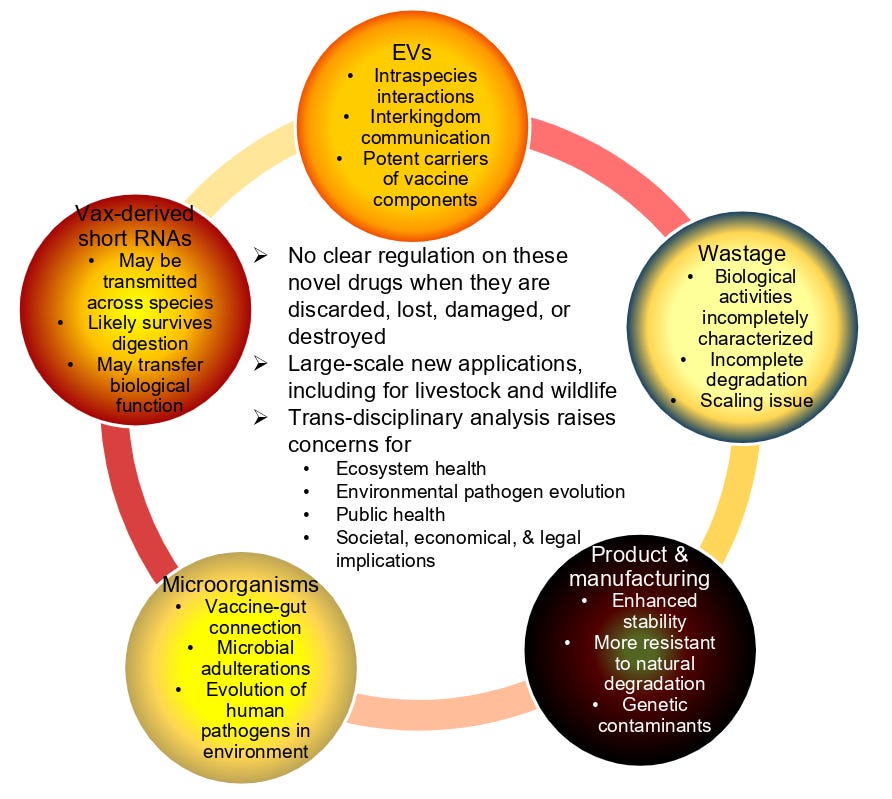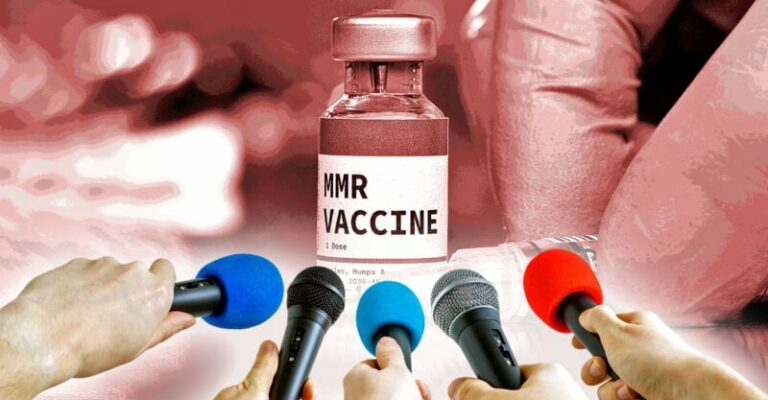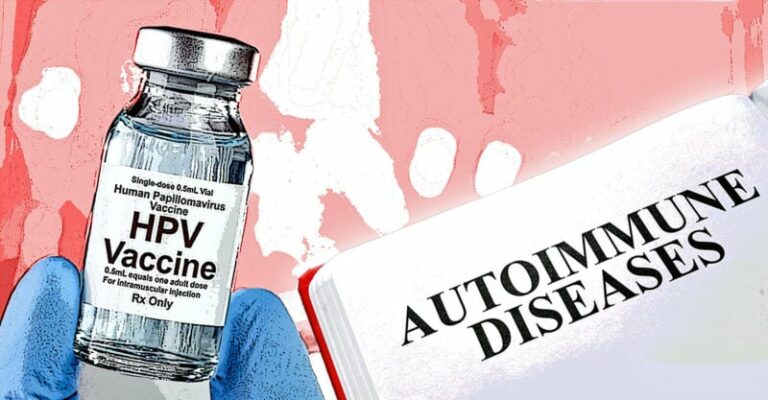Can compounds of mRNA vaccines survive digestion and be biologically active in consuming humans or animals?
Source : TKP.at, Ph.D.Ph.D. Siguna Müller, Siguna’s Substack, 03 April 2024
Are we approaching a potentially global disaster via broad-scale livestock and wildlife RNA vaccination?
Thanks for reading my Substack. After I had posted my preprint last week on the environmental risks of existing and emerging human and animal mRNA vaccines, I kept pondering one key open question.
I previously described how microbiota and extracellular vehicles (EVs) may take up and transfer vaccine-derived material to other organisms, even across species and kingdoms. But how is the material taken up by the targeted organisms? And if they are capable of such an uptake, what happens to the material, and what does it do (if anything) in the recipient organism?
In my book, I focused extensively on the concern of vaccine-derived RNA fragments assuming unintended biological functions as regulatory RNAs. This goes back to manufacturing problems of synthetic RNAs. It has long been known these also include many unintended byproducts with many of them being double-stranded RNAs.
These well-established manufacturing challenges are difficult to resolve. Many groups have tried different approaches, including those that eventually led to the Nobel-prized modifications. Nonetheless, while the last few months have seen some (well-justified) attention on the DNA contaminants, the problem of RNA contamination has not gone away either. Consequently, different people will be injected with different types and amounts of aberrant RNA fragments and some of them will also form in vivo.
Strikingly, for the COVID-19 vaccines, the RNA shares extensive homologous features with human RNAs, which can be problematic for several reasons. Because of the scope of the planned animal vaccination, it is expected there will be substantial similarities between vaccine-derived RNA fragments and those of environmental organisms. This means that vaccine-derived RNAs are likely to act as regulatory RNAs and maintain their potential biological functions in exposed organisms – possibly even across kingdoms.
I wrote about this briefly in the first version of the preprint and have meanwhile realized that the literature on some related issues paints a damning picture of what could be unfolding in the context of mRNA vaccines.
Some of this is related to the question of what happens when such exogenous RNAs get ingested. This is clearly a critically important consideration. No wonder that we have not seen much of this in MSM and other main/official sources!
I have further extended the issue of regulatory RNAs, their transport across species, and uptake by the recipient organisms, and added some sections to the preprint. I describe three different uptake mechanisms, and each may have horrific consequences.
Here is an excerpt from my updated preprint “Existing and Emerging mRNA Vaccines and their Environmental Impact – a Transdisciplinary Assessment.”
Short RNAs such as miRNAs exhibit ultra-stability in the extracellular environment which has to a large part been attributed to them being packaged into exosomes. Their EV-based transport enables their broad dissemination across species as discussed above.
The uptake of such EVs by the targeted organisms is an important question. Three main mechanisms can be envisioned:
- Via direct interaction of EVs: For example, exosomes secreted by plants have been shown to directly interact with fungal, mammalian, and bacterial cells [50].
- Symbiotic interactions and those shaping the host-parasite arms race: EVs also play a substantial role in interactions between a host and its symbiotic or invading organisms [49]. Indeed, the majority of examples of cross-species transfer of short regulatory RNAs come from interactions between host and invader. Numerous examples are known of the mutual exchange between hosts and their pathogens, parasites, and symbionts, both as a defense and a means to hijack this defense [62].
- One of the most troubling aspects of exogenous RNAs is that they may survive digestion and thereby remain active in recipient organisms. Already in 2012, Zhang and colleagues [61] reported that plant short RNAs ingested from food, pass through the GI tract, enter into blood, accumulate in tissues, and can regulate transcripts in consuming animals. Surprisingly, a specific plant miRNA from ingested rice even appeared to modulate the expression of a receptor involved in LDL removal from mouse plasma. Subsequent studies investigating inter-kingdom transfer of animal and plant miRNAs have reported contradictory or negative results [62]. However, a detailed follow-up analysis [62] validated the substantial role of food/feed-mediated transfer of regulatory RNAs across kingdoms. They demonstrated the accumulation and function of numerous dietary miRNAs in specific animal tissues, which was validated by three different techniques (high-throughput sequencing utilizing high sequencing reads only, qRT-PCR assays with various controls, and Northern blots). In addition, after reviewing a number of independent studies, they found strong evidence that ingested short RNAs can have a functional impact on consuming organisms.
Needless to say, the ramifications could be horrific.
There are several reasons why vaccine-derived genetic compounds may be transferred to various exposed species but also accumulate in large enough quantities to cause a biological effect in the recipient organism.
As indicated, one of the transport mechanisms is through dietary uptake. This would cause a tremendous risk to the safety of the global food supply, and more so as we are facing a rush to mRNA-vaccinate livestock and wildlife at scale.
The above would also suggest that COVID-19 vaccine material, which has been found in the breast milk of vaccinated mothers, survives digestion when fed to their babies. If so, it would corroborate some of the many anecdotal tragic reports (not described in the preprint) of the shocking and heartbreaking effects this had on those poor babies.
Furthermore, the “arms race” between host and pathogen mentioned above could further the development of new pathogens. More generally, the effects of mRNA vaccination on the entire ecosystem could be enormous, or even irreversible (e.g. via genetic adulterations of exposed organisms).
I am not aware that these environmental risks are carefully studied and scrutinized in an unbiased manner. The lack of policy and regulation could even support the deliberate broad dissemination of certain synthetic RNAs, camouflaged as vaccines, creating potent biological weapons.
Overall, if mRNA vaccination continues at scale, we may face an enormous “global public health threat to animals and humans.” However, official regulators may fail to adequately recognize the source of this new threat.
As I am pursuing publication of this work as a journal article, I would appreciate your reading and sharing the preprint (I was told journals track the popularity of a preprint). Please also let me know of comments or ideas to support this endeavor. It does concern us all – indeed this is what OneHealth truly entails. I remain hopeful that if these risks are adequately recognized that their potential will be taken seriously.

(source: https://osf.io/preprints/osf/k2grj)
Suggest a correction







